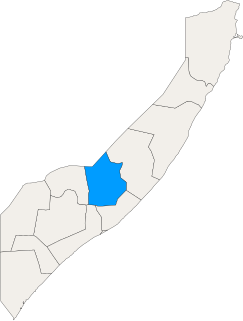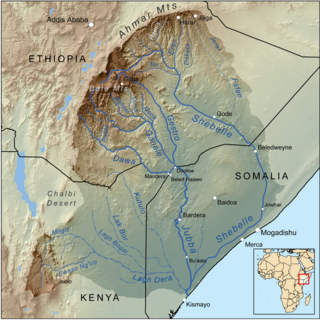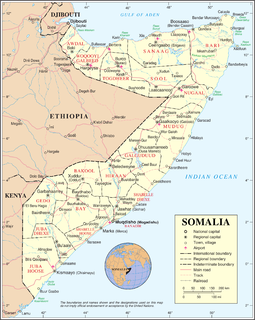
Galguduud is an administrative region (gobol) of Galmudug state in central Somalia. Its administrative capital is Dusmareb.

Hiran is an administrative region (gobol) in central Somalia and part of the Hirshabelle State.

Lower Shabelle is an administrative region (gobol) in southern Somalia.

The Jubba River or Juba River is a river in southern Somalia which flows through the autonomous region of Jubaland. It begins at the border with Ethiopia, where the Dawa and Ganale Dorya rivers meet, and flows directly south to the Somali Sea, where it empties at the Goobweyn juncture. The Jubba basin covers an area of 749,000 km2 (289,000 sq mi). The Somali regional state of Jubaland, formerly called Trans-Juba, is named after the river.

The Shebelle River begins in the highlands of Ethiopia, and then flows southeast into Somalia towards Mogadishu. Near Mogadishu, it turns sharply southwest, where it follows the coast. Below Mogadishu, the river becomes seasonal. During most years, the river dries up near the mouth of the Jubba River, while in seasons of heavy rainfall, the river actually reaches the Jubba and thus the Somali Sea.

Merca is an ancient port city in the southern Lower Shebelle province of Somalia. It is located approximately 109 km (68 mi) to the southwest of the nation's capital Mogadishu. Merca is the traditional home territory of the Bimal clan and was the center of the Bimal Revolt or Merka Revolt.
The Silcis are a Somali subclan. They are part of the Gorgate subclan of the Hawiye clan, which is one of the major clans of Somali people. The Silcis inhabit the traditional coastal region of Benadir in the southern part of Somalia. This region should not be confused with the much smaller present day Banaadir administrative region (gobol) which contains Somalia’s capital Mogadishu. Silcis live, or have historically lived, along the Shabeelle River in towns such as Afgooye and Jowhaar, as well as along the coast, especially in Mogadishu and Warsheekh.

Somali literature refers to the literary tradition of the Somali people. It ranges from Islamic poetry and prose produced by the region's scholars and Sheikhs of centuries past to works of fiction from contemporary writers.

Af Maay commonly spelled Maay (also known as Af-Maay Maay, is a language of the Cushitic branch of the Afro-Asiatic family, closely related to the Somali language. It is mainly spoken in Somalia and adjacent parts of Ethiopia and Kenya. In Somalia, it is widely spoken in South West state, Jubaland state and Banadir. Scholars debate whether Af-Maay is a Somali language on its own, or is one of the two main dialects that form the Somali language.

Afgooye is a town in the southwestern Somalia Lower Shebelle region of Somalia. It is the center of the Afgooye District. Afgooye is the third largest city of Southwest State. Afgooye is one of the oldest towns on the lower Shebelle valley, 30 kilometers north of Mogadishu. Afgooye is the site of Lafoole college, the first college of education in Somalia, built on the site of the battle of Lafoole of 1896. Afgooye is also known for the Istunka, the annual "stick fight" carnival commemorating the New Year in the riverine region. It was a trade center for the Silcis Dynasty in the medieval period then fell under Ajuran rule. Around the late 17th century, Afgooye became the capital of Geledi Sultanate.

The Mogadiscio-Villabruzzi Railway is an historical railway system that ran through southern Somalia. It was constructed between 1914 and 1927 by the colonial authorities in Italian Somaliland. The railway connected the capital city Mogadishu with Afgooye, and subsequently with Villaggio Duca degli Abruzzi - usually called "Villabruzzi". The line was later dismantled by British troops during World War II. Plans for re-establishing the railway were made in the 1980s by the Siad Barre administration, but were aborted after the regime's collapse.

Istunka, also known as isgaraac, is a festival held annually in Afgooye, Somalia on the Somali new year. The tournament was developed during the medieval Ajuran period, and was centralized in the 19th century under the Sultanate of the Geledi. Consisting of several teams engaging each other in mock combat, it is celebrated alongside other ceremonies such as Dabshiid.
The Sultanate of the Geledi also known as the Gobroon Dynasty was a Somali kingdom that ruled parts of the Horn of Africa during the late-17th century and 19th century. The Sultanate was governed by the Gobroon dynasty. It was established by the Geledi soldier Ibrahim Adeer, who had defeated various vassals of the Ajuran Sultanate and elevated the Gobroon to wield significant political power. Following Mahamud Ibrahim's consolidation, the dynasty reached its apex under Yusuf Mahamud Ibrahim, who successfully modernized the Geledi economy and eliminated regional threats with the Conquest of Bardera in 1843, and would go on to receive tribute from Said bin Sultan the ruler of the Omani Empire. Geledi Sultans had strong regional ties and built alliances with the Pate and Witu Sultanates on the Swahili coast. Trade and Geledi power would continue to remain strong until the death of the well known Sultan Ahmed Yusuf in 1878. The sultanate was eventually incorporated into Italian Somaliland in 1911.

The Railway Stations in Somaliland were served by the Mogadishu–Villabruzzi Railway of 114 km.
The Geledi are a Somali clan that live predominantly near the city of Afgooye. They are a subclan of Rahanweyn and led the Geledi sultanate during the late 17th to early 20th century. They are divided into two main lineage groups: the Tolweyne and the Yabadhaale.
The Somali Division 2 is the second football division in Somalia. The league is contested by 08* clubs, was up dated 2015.

This is a 2018 timeline of events in the Somali Civil War (2009–present).

On 18 January 2020, a suicide car bombing killed four and injured at least 20 others in Afgooye, approximately 30 kilometres (19 mi) from the Somali capital, Mogadishu. Most of the casualties were police officers protecting Turkish contractors building a road. The al-Qaeda-linked extremist group al-Shabaab claimed responsibility for the attack.
The August 2020 Mogadishu bombing was a suicide car bombing on 8 August 2020 at the gates of the 12th April Army Brigade military base close to the recently reopened Mogadishu sports stadium in the Warta Nabadda district of Mogadishu. The attack killed at least eight people and wounded fourteen others. The jihadist group al-Shabaab claimed responsibility for the attack.










